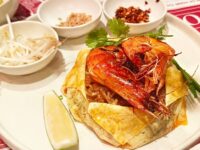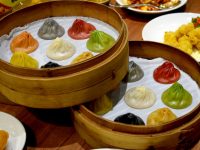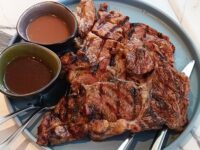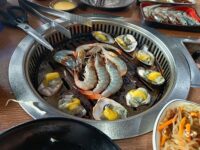Yesterday, I was invited to see a Korean Sool exhibit at the Korean Cultural Center in the Philippines in BGC. We learned all about the different Korean alcoholic beverages, called sool.
More interestingly, we had a workshop showing us how easy it is to make rice wine! All about that below.
Our host was Miss Jisung Chun, a Korea Traditional Liquor Sommelier, who introduced us to the different types of Korean alcoholic beverages. I’m not going to discuss each type because I’m not an expert and don’t think I remember everything she taught us, anyway, so here’s the link to the Wikipedia article on Korean Sool which discusses it much better than I can 🙂
All I can say is that I really liked the Makgeolli (pronounced mak-koli) – this is a sweet, milky Korean alcoholic drink that is also the most popular type of alcoholic beverage in Korea. There are even some makgeolli that are infused with different fruits and flowers for flavor.
There’s also an exhibit that shows the history of Korean Sool, how it’s brewed, what foods are usually paired with what, drinking etiquette, etc…

Different types of Korean alcoholic beverages:
HOW TO MAKE KOREAN RICE WINE (BASIC)
Making Korean rice wine is actually pretty easy!
All you need are 3 ingredients – rice, water, and a fermentation starter the Koreans call nuruk. You can order nuruk from specialty shops or from Korean online stores.
The ingredients were already set up for us, and all we had to do was mix them together. The rice has to be Korean rice, which is sort of rounder and stickier. The rice is steamed for 40 minutes and then cooled to room temperature. The steamed rice will end up drier than the usual rice we are used to, and that’s what we want.
Equal amount of rice to water is used. So, for example, if you use 500g of rice, you would use 500ml of water. As for the nuruk, use 1/10th. So for 500g of rice, use 50g of nuruk.
First, put the cooled rice into the container, try to break any lumps apart but make sure you don’t smoosh the rice grains.
Put the nuruk into the container, try to mix it evenly.
Finally, pour the water into the container.
Gently mix them all evenly as best as you can. That’s it. All that’s left is to let it ferment. We each took home our rice wine mix to ferment at home. If the rice seems to soak up all the water, don’t worry about it. It will release the liquid again during fermentation.
Now for the fermentation:
Close the lid, but leave it open just a little to let air escape. For our container, we left the lid open about a half turn. Keep it like this for 3 days. Keep this in a cool, dark place – no sunlight or high temps!
On the 4th day, close the lid completely. Then leave this for another 7 days.
On the 11th day, you’ve got makgeolli! Open the lid, taste your rice wine. If you are okay with the taste and sweetness, just filter your wine through a cheesecloth and that’s it. Keep the filtered rice wine in the refrigerator.
If you are not yet happy with the taste and want to develop more alcohol or reduce the sweetness, leave it for a few more days, occasionally tasting to check the flavor. Once you are okay with the flavor / alcohol, filter it just like I described above.
I asked if I could keep my fermenting rice wine in the refrigerator, and Ms. Jisung said I could, but it would take longer to ferment, maybe 30 days instead of 11, depending on how cold my ref is. Upside to doing this is that it will reduce the bitterness 🙂 So I will do this for my rice wine instead.
So today is Day 2 of fermentation, and I have to wait 29 more days. I hope my little rice wine experiment turns out delicious.
Once you’ve got the hang of it, you can experiment more and add flavoring like fruits, berries, etc…
The Korean Cultural Center in the Philippines is located in BGC, at the 2nd Floor of the Mancor Corporate Building (the building with the Subaru dealership) – it is just across the street from Jollibee, and almost beside St. Luke’s on 32nd St. It aims to expand understanding of Korean culture. They host a library and have film screenings. They also have different classes available, ranging from Korean language, Korean cooking, singing, dancing, to Korean martial arts and Korean folk arts such as painting.
The Korean Cooking class is P400 per session (2.5 hours). I’m really interested to learn so I might try a session soon. It’s Tuesdays 9:30am – 12nn (AM Session) and 2:00pm – 4:30pm (PM Session).
Korean Cultural Center in the Philippines
2/F Mancor Corporate Building, 32nd St., BGC, Taguig 1634
Contact: (02) 555-1711
Email: classes@koreanculture.ph
Facebook: @koreanculturalcenterph
Instagram, Twitter, YouTube: kccphil


























